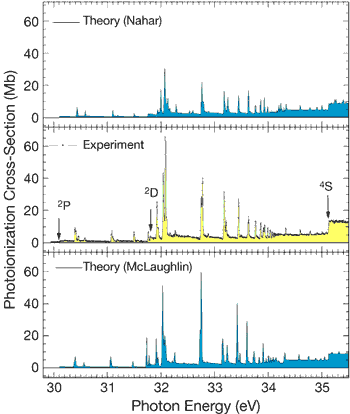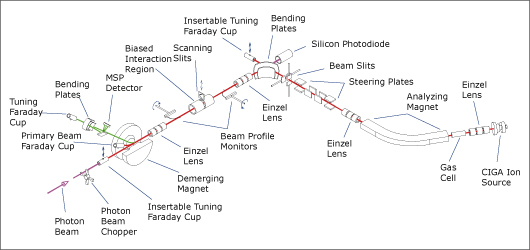
Photoionization of Metastable Ions: First Absolute Measurement
Beginning physics students can often check their calculations by turning to the answers given in the backs of their books. Unfortunately, there is no such recourse for checking state-of-the-art theoretical calculations such as those that describe the structure of ions and their interactions with photons. Although these calculations are crucial to our understanding of both astrophysical and laboratory plasmas, experiments that allow the critical testing of theory have only relatively recently become possible with the advent of third-generation synchrotron light sources of exceptional brightness. At the ALS, researchers from the U.S. and Mexico used a newly developed ion-photon-beam endstation to obtain high-resolution measurements of the photoionization cross-section of oxygen ions in metastable (long-lived) excited states. The comparison of the results with two independent theoretical calculations is believed to be the first reported for photoionization from metastable states of ions.
|

Over 99% of the atoms in the known universe exist in the ionized "plasma" state, and the light they emit and absorb carries most of our knowledge about distant stars and nebulae. Oxygen is the third-most abundant element in the universe, and its ions play important roles in stellar as well as terrestrial atmospheres. Metastable states of O+ are produced by the photoionization of oxygen in the earth's ionosphere and strongly influence the chemistry of the thermosphere, a tenuous layer of the atmosphere where the space shuttle and other satellites orbit. A detailed understanding of the structure of ions and their interactions with photons is critical to many other fields, including the study of laboratory plasmas and their technological applications. Until recently, most of this understanding was based on theoretical calculations, with few experimental benchmarks. |
Keeping It Real |
||
Photoionization of an ion occurs primarily by two mechanisms. Direct photoionization can occur at any photon energy greater than the ionization potential of the ion. Indirect photoionization is a two-step process involving excitation of the ion's electronic core and the subsequent ejection of an electron as the ion "relaxes." Because the photon's energy is completely absorbed in the initial step, indirect ionization occurs only at discrete photon energies exceeding the ionization potential and corresponding to differences between the ion's energy levels. The superposition of the probabilities of the two mechanisms gives the total ionization cross-section, a characteristic profile whose energies, widths, and shapes provide a powerful probe of the internal electronic structure and dynamics of ions. However, such measurements are difficult, requiring intense vacuum ultraviolet radiation to get a detectable signal from low-density ion beams. The first absolute measurements of the photoionization of a metastable ion, O+, were carried out at the ALS, where a fast O+ ion beam was merged with a counterpropagating photon beam whose energy could be continuously scanned. Two metastable excited states of O+, the 2P and 2D levels, are significantly populated in the ion beam relative to the 4S ground state and have mean lifetimes of 14 seconds and 1.3 hours, respectively, significantly longer than the ion flight time. The ion–photon interaction produced O2+ photoion products, which were separated from the main beam and counted. The ion and photon beam fluxes were measured simultaneously. The initial metastable-state fraction (57%) was measured in an independent experiment.
The absolute photoionization cross-section measurements for a mixture of metastable and ground-state O+ ions were compared with the predictions of two independent theoretical calculations. While there is correspondence between the energy positions and strengths of some of the cross-section peaks, the differences between the theoretical and experimental profiles indicate sensitivity of the theories to the set of mathematical functions used to represent the electronic states of O+.

Research conducted by A.M. Covington, A. Aguilar, I.R. Covington, M. Gharaibeh, C.A. Shirley, R.A. Phaneuf (University of Nevada, Reno); I. Álvarez, C. Cisneros, G. Hinojosa (Universidad Nacional Autónoma de México); J.D. Bozek, I. Dominguez, M.M. Sant'Anna, A.S. Schlachter (ALS); N. Berrah (Western Michigan University); S.N. Nahar (Ohio State University); and B.M. McLaughlin (Harvard Smithsonian Center for Astrophysics). Research funding: U.S. Department of Energy (DOE), Office of Basic Energy Sciences (BES); DOE Nevada Experimental Program to Stimulate Competitive Research (EPSCoR); National Science Foundation (NSF); Consejo Nacional de Ciencia y Tecnología (CONACyT), México; Dirección General de Asuntos del Personal Académico (DGAPA), México; Conselho Nacional de Desenvolvimento Científico e Tecnológico (CNPq), Brazil; Ohio Supercomputer Center; Institute for Theoretical Atomic and Molecular Physics (ITAMP), Harvard Smithsonian Center for Astrophysics; and Engineering and Physical Sciences Research Council (EPSRC), UK. Operation of the ALS is supported by BES. Publication about this research: A.M. Covington, A. Aguilar, I.R. Covington, M. Gharaibeh, C.A. Shirley, R.A. Phaneuf, I. Álvarez, C. Cisneros, G. Hinojosa, J.D. Bozek, I. Dominguez, M.M. Sant' Anna, A.S. Schlachter, N. Berrah, S.N. Nahar, B.M. McLaughlin, "Photoionization of Metastable O+ Ions: Experiment and Theory," Phys. Rev. Lett. 87, 243002 (2001). |
|||
More ALS Science
